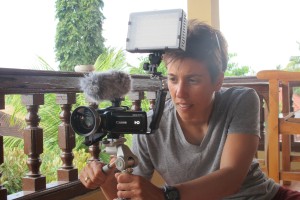How did two not-particularly-creative office workers with no media experience suddenly become documentary filmmakers? Honestly, link we ask ourselves the same question all the time.
What started out as my personal dream to travel has evolved into a bigger mission to tell the stories of extraordinary people from the global queer community. Amazingly, so many of you have believed in our mission, and with your support we have raised 80% of our $6,000 fundraising goal.
These funds go to pay for our website development, camera equipment, and video production. We’ve tried to stick to the bare minimum in terms of gear, but we’re realizing that some stuff you simply can’t go without if you want to hit a certain quality level. We just picked up our latest order from the Bali post office which included lighting and sound accessories, a wide angle lens, a second tripod, and an instructional DVD crash course on how to make a documentary (we’re fully embracing the learn-as-you-go film school method).
Given our combined years of zero experience in filmmaking, we’re making a ton of mistakes. Its a bit embarrassing when your interview subjects are giving you suggestions on camera angles and lighting, but we’re improving tremendously. In addition to the interviews and video logs that we’re producing during our travels, our goal is to produce a documentary at the end of the trip to culminate this project. Check out our new video page which features our latest video about camper-vanning our way through New Zealand with Supergay stories from Australia and Indonesia to come.
Here are our top learnings thus far on how to become a guerrilla documentary filmmaker:
1. Get advice from experts…a lot of advice. People go to film school for a reason, and their work is at a whole different level than ours. We’ve been incredibly lucky to find a couple of professional filmmakers who are contributing their expertise to our project. We’ve been sending each of our videos to Lisa’s friend Ami, a documentary filmmaker, and she’s generously provided advice on everything from camera angles to storyline. We’ve also found some unexpected help along the way. In Bali we met Jorge, a National Geographic photographer and filmmaker from Chile who spent a whole day teaching us the fundamentals of filmmaking. Thanks to Jorge, we now have a process for creating a shoot schedule, and we understand the importance of shooting a lot of B roll footage.
2. Act like you’re a real filmmaker. When we first started filming, we felt rather sheepish about whipping out our video cameras all the time for fear of being intrusive or downright annoying. But the result of sheepish filming is poor footage: clips that are too short, shots that are too far away, and audio that is too quiet. When Jorge demonstrated how to film, he would position himself in front of his subjects with a sense of purpose and confidence. We’re trying to take on a similar attitude of being “real filmmakers,” and the more we shoot, the more we comfortable we feel with the camera.
3. Talk to everyone, you never know who might make a great subject. In our first two countries, Lisa was able to set up the bulk of our interviews before arriving. However, in Indonesia we had no contacts, and our usual method of emailing in-country LGBT organizations didn’t exactly work for a Muslim country where homosexual activity is mostly in the closet. To meet gay people, we stared talking to anyone and everyone. It doesn’t always feel comfortable to ask someone whether or not he or she is gay, but we’ve found that we can trust our gaydar. Once we share the status of our own relationship and the purpose of our travels, people open up. Indeed, a random conversation with a server at a restaurant resulted in one of our best interviews. We spent the following day with our new friend and his boyfriend, getting an intimate look at gay life in Indonesia and capturing it all on film.
4. Just shut up and shoot. Honestly, most of the time we have no idea what we are doing. Going into this project, neither of us had touched a video camera besides the ones on our cell phones, and neither of us had ever done video editing of any sort. For better or worse, we decided to just shut up and shoot. Most days, we feel like we’ve bitten off way more than we can chew. But at the end of the day, we believe in our project, and we believe that the people we are meeting have stories that are worth telling. If Out and Around can provide an authentic glimpse into the lives of gay people around the world, then we will have accomplished our mission.

